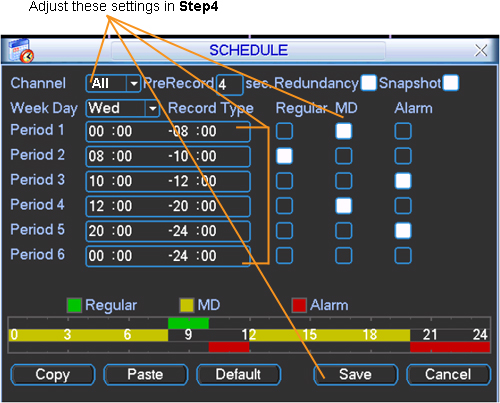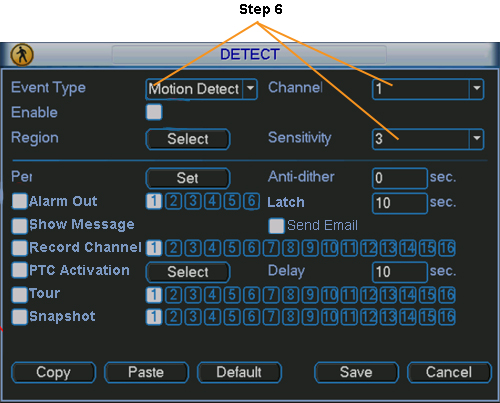iMaxCamPro (Bronze, Gold, Platinum) Motion Detection Setup
:
from
to
Clear
Clear
Motion Detection Setup (locally)
Bronze, Gold, and Platinum iMaxCamPro DVR's
Back to iMaxCamPro Support | Support Home
Step 1
Begin by logging into the recorder. If you left click your mouse, or press enter you will be prompted to login. The default user/pass is admin/admin. Click OK.
Step 2
If successful, you should be at the main menu. From here, we’re going to navigate to the Settings menu. Once in settings, click on the Schedule submenu.
Step 3
Our first task for the setup, is to actually set a time period for motion to be recorded. This guide will detail a 24/7 motiondetect setup for all channels.
Step 4
From the channel pull-down menu, select All. From the weekday pull-down menu, again select all. Now, ensure your time period 1 is setfrom “00:00 – 24:00” (in other words, all hours of the day). To verify this, your graph at the bottom should be yellow from 0 to 24. Once finished, click Save at the bottom.

Click to enlarge
Step 5
You should now be back at the Settings menu. For our next task, we need to configure our detection settings as well as our record channels. From the settings menu here, click on Detect.

Click to enlarge
Step 6
In the detect menu here, it is very important that we proceed channel by channel, instead of using the “all” channel option, as this can negatively impact our configuration. This guide will begin with settings for channel 1, so make sure you have 1 selected as your channel at the top right.
Step 7
The top portion of this menu contains all of your event settings. With channel 1 selected, we want to make sure our event type is alsoset to Motion Detect and that you have Enable highlighted white. Adjust your sensitivity as needed (6 being the highest, most sensitive). You can also mask out trouble spots from the image (flags, ceiling fans, etc) by clicking the Select button next to Region. On the region grid, any red tinted grid square is an active detection square, and will trigger motion accordingly. A passive square will have no tint, and should actually display the camera image. Once you’re satisfied with your grid, you can right click or hit escape to return to the previous menu.
Step 8
The bottom portion of this menu contains all of your reactions to the event at the top of this menu. There are quite a few more reactions to motion than just recording, however this guide is only detailing the record channel function. Again, we should have our event channel (at the top) selected as channel 1 still. From here, we want to highlight the checkbox to the left of record channel (enabling the recording response for the event), and also select a channel to record from the right side here (1 should be highlighted by default). Once you’ve got this set, click save at the bottom. If you’re doing additional channels, it is not necessary to click save after every channel – you can simply switch to the next event channel at this point and save at the very end.
*Note that your record channel does not need to match your event channel, but please be aware that you will not record on the event channel by default unless you have it selected from the row of record channels!
Step 9
Repeat steps 7 and 8 for any additional channels.
Step 10
You should be finished with the detection setup at this point – all that remains is troubleshooting to make sure you’re configuration is working properly. If you return back to your camera views, you will see a few key indicator icons that help you diagnose recording issues. If you see the motion indicator but no recording indicator, check your record channel setting.
Bronze, Gold, and Platinum iMaxCamPro DVR's
Back to iMaxCamPro Support | Support Home
Step 1
Begin by logging into the recorder. If you left click your mouse, or press enter you will be prompted to login. The default user/pass is admin/admin. Click OK.
Step 2
If successful, you should be at the main menu. From here, we’re going to navigate to the Settings menu. Once in settings, click on the Schedule submenu.
Step 3
Our first task for the setup, is to actually set a time period for motion to be recorded. This guide will detail a 24/7 motiondetect setup for all channels.
Step 4
From the channel pull-down menu, select All. From the weekday pull-down menu, again select all. Now, ensure your time period 1 is setfrom “00:00 – 24:00” (in other words, all hours of the day). To verify this, your graph at the bottom should be yellow from 0 to 24. Once finished, click Save at the bottom.

Click to enlarge
Step 5
You should now be back at the Settings menu. For our next task, we need to configure our detection settings as well as our record channels. From the settings menu here, click on Detect.

Click to enlarge
Step 6
In the detect menu here, it is very important that we proceed channel by channel, instead of using the “all” channel option, as this can negatively impact our configuration. This guide will begin with settings for channel 1, so make sure you have 1 selected as your channel at the top right.
Step 7
The top portion of this menu contains all of your event settings. With channel 1 selected, we want to make sure our event type is alsoset to Motion Detect and that you have Enable highlighted white. Adjust your sensitivity as needed (6 being the highest, most sensitive). You can also mask out trouble spots from the image (flags, ceiling fans, etc) by clicking the Select button next to Region. On the region grid, any red tinted grid square is an active detection square, and will trigger motion accordingly. A passive square will have no tint, and should actually display the camera image. Once you’re satisfied with your grid, you can right click or hit escape to return to the previous menu.
Step 8
The bottom portion of this menu contains all of your reactions to the event at the top of this menu. There are quite a few more reactions to motion than just recording, however this guide is only detailing the record channel function. Again, we should have our event channel (at the top) selected as channel 1 still. From here, we want to highlight the checkbox to the left of record channel (enabling the recording response for the event), and also select a channel to record from the right side here (1 should be highlighted by default). Once you’ve got this set, click save at the bottom. If you’re doing additional channels, it is not necessary to click save after every channel – you can simply switch to the next event channel at this point and save at the very end.
*Note that your record channel does not need to match your event channel, but please be aware that you will not record on the event channel by default unless you have it selected from the row of record channels!
Step 9
Repeat steps 7 and 8 for any additional channels.
Step 10
You should be finished with the detection setup at this point – all that remains is troubleshooting to make sure you’re configuration is working properly. If you return back to your camera views, you will see a few key indicator icons that help you diagnose recording issues. If you see the motion indicator but no recording indicator, check your record channel setting.


